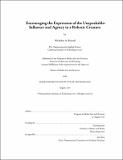| dc.contributor.advisor | Tod Machover. | en_US |
| dc.contributor.author | Knouf, Nicholas A | en_US |
| dc.contributor.other | Massachusetts Institute of Technology. Dept. of Architecture. Program in Media Arts and Sciences. | en_US |
| dc.date.accessioned | 2008-05-19T15:01:26Z | |
| dc.date.available | 2008-05-19T15:01:26Z | |
| dc.date.copyright | 2007 | en_US |
| dc.date.issued | 2007 | en_US |
| dc.identifier.uri | http://hdl.handle.net/1721.1/41561 | |
| dc.description | Thesis (S.M.)--Massachusetts Institute of Technology, School of Architecture and Planning, Program in Media Arts and Sciences, 2007. | en_US |
| dc.description | This electronic version was submitted by the student author. The certified thesis is available in the Institute Archives and Special Collections. | en_US |
| dc.description | Includes bibliographical references (p. 165-177) and index. | en_US |
| dc.description.abstract | The boundary between subject and object is becoming ever-the-more blurred by the creation of new types of computational objects. Especially when these objects take the form of robotic creatures do we get to question the powerful impact of the object on the person. Couple this with the expression of internal, unspoken experience through the making of non-speech sounds and we have a situation that demands new thoughts and new methodologies. This thesis works through these questions via the design and study of syngvab, a robotic marionette that moves in response to human non-speech vocal sounds. I draw from the world of puppetry and performing objects in the creation of syngvab the object and its stage, showing how this old tradition is directly relevant for the development of non-anthropomorphic, non-zoomorphic robotic creatures. I show how this mongrel of an object requires different methodologies of study, pulling from actor-network theory to examine syngvab in a symmetric manner with the human participants. The results of a case study interaction with syngvab support the contention that non-speech sounds as drawn out by a robotic creature are a potent means of exploring and investigating the unspeakable. | en_US |
| dc.description.statementofresponsibility | by Nicholas A. Knouf. | en_US |
| dc.format.extent | 182, [1] p. | en_US |
| dc.language.iso | eng | en_US |
| dc.publisher | Massachusetts Institute of Technology | en_US |
| dc.rights | M.I.T. theses are protected by
copyright. They may be viewed from this source for any purpose, but
reproduction or distribution in any format is prohibited without written
permission. See provided URL for inquiries about permission. | en_US |
| dc.rights.uri | http://dspace.mit.edu/handle/1721.1/7582 | en_US |
| dc.subject | Architecture. Program in Media Arts and Sciences. | en_US |
| dc.title | Encouraging the expression of the unspeakable : influence and agency in a robotic creature | en_US |
| dc.type | Thesis | en_US |
| dc.description.degree | S.M. | en_US |
| dc.contributor.department | Program in Media Arts and Sciences (Massachusetts Institute of Technology) | |
| dc.identifier.oclc | 225102821 | en_US |
